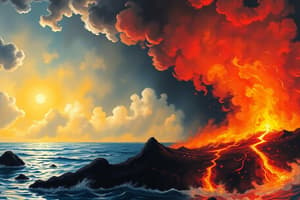Podcast
Questions and Answers
Which of the following best describes the Pacific Ring of Fire?
Which of the following best describes the Pacific Ring of Fire?
- A 25,000-mile region of volcanoes that are seismically active. (correct)
- A mountain range located in the Philippines.
- An underwater trench in the ocean.
- A flat area with no volcanoes.
The Sierra Madre is the shortest mountain range in the Philippines.
The Sierra Madre is the shortest mountain range in the Philippines.
False (B)
What is the primary component of the lithosphere?
What is the primary component of the lithosphere?
Crust and upper mantle
The __________ is the point inside the Earth where an earthquake originates.
The __________ is the point inside the Earth where an earthquake originates.
Match the following types of waves with their descriptions:
Match the following types of waves with their descriptions:
How many major tectonic plates are there on Earth?
How many major tectonic plates are there on Earth?
The method of triangulation is used to determine the epicenter of an earthquake.
The method of triangulation is used to determine the epicenter of an earthquake.
What is the outermost layer of the Earth called?
What is the outermost layer of the Earth called?
Study Notes
Pacific Ring of Fire
- A vast 25,000-mile-long area featuring numerous volcanoes and seismic activity.
- Contains many of the world's most active volcanoes, primarily situated along oceanic boundaries.
Mountains and Volcanoes
- Mountains are land masses that rise significantly higher than hills.
- Mayon Volcano, a stratovolcano, is known for its perfectly conical shape and is located in Albay, Bicol, Philippines.
Mountain Ranges
- Mountain ranges consist of a series of connected mountains arranged in a linear formation.
- Sierra Madre is the longest mountain range in the Philippines, located in the northeastern part of Luzon.
Structure of the Earth
- Comprised of several layers:
- Crust
- Mantle
- Outer Core
- Inner Core
Lithosphere and Plate Tectonics
- The lithosphere consists of the crust and the upper mantle and is in constant, albeit slow, motion.
- Tectonics refers to the movement of the lithosphere, influencing geological phenomena.
- Plate tectonics lead to the division of larger tectonic plates into smaller microplates, each covering less than 380,000 square miles.
- There are approximately 57 tectonic plates on Earth, including major plates like:
- African Plate
- Antarctic Plate
- Eurasian Plate
- North American Plate
- South American Plate
- Indo-Australian Plate
- Pacific Plate
Earthquakes
- Defined as the shaking or trembling of the Earth.
- Epicenter is the point on the Earth's surface directly above the earthquake's focus.
- Focus is the originating point within the Earth where the earthquake starts.
Seismic Measurement
- Seismograph is an instrument used to measure and document earthquakes' vibrations.
- Seismic waves are mechanical waves of acoustic energy generated during an earthquake.
- Seismogram records ground motion resulting from seismic waves.
- Primary waves (P-waves) are the first recorded by a seismograph, followed by secondary waves (S-waves) and surface waves (Love waves or L-waves).
Earthquake Location Methods
- The triangulation method is utilized to pinpoint an earthquake's location.
- Seismometers are represented as green dots, the earthquake location as a circle, and the intersecting points of circles indicate the epicenter location.
Studying That Suits You
Use AI to generate personalized quizzes and flashcards to suit your learning preferences.
Description
Test your knowledge on the Pacific Ring of Fire, its volcanoes, and the structure of the Earth. This quiz covers significant geological features, including major mountains and the Earth's layers such as the crust, mantle, and core. Dive into the fascinating dynamics of our planet's geology!




